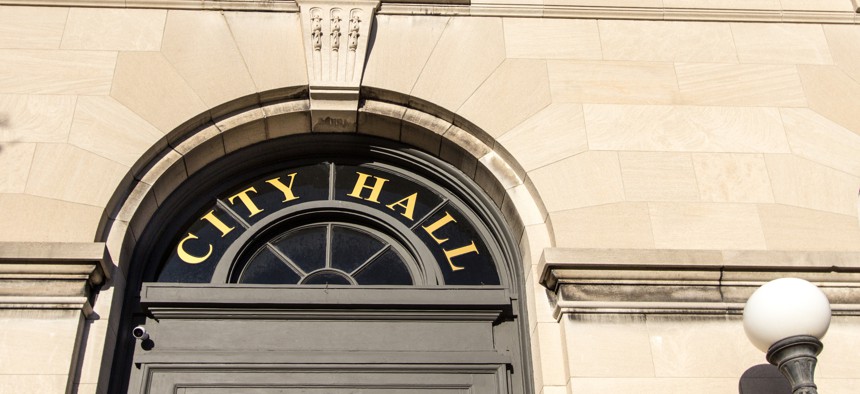State, Local Governments Could Get an Extra Year to Spend Covid Funds

Shutterstock/ ehrlif
President Trump on Tuesday disparaged the coronavirus relief package approved by Congress this week. The deal does not appropriate more direct funding for local governments and states, but if it does go forward, it would extend the deadline for them to spend previous funds.
State and local governments would be granted another year to spend federal coronavirus relief funds under the aid package approved by Congress this week and sent to President Trump.
While local leaders were disappointed that more direct funding to local and state governments wasn’t included in the aid deal, the deadline flexibility would mean recipients of previous federal funding no longer face a mad dash to spend the money before the end of the year.
State and local governments had pleaded for more time to spend the $139 billion appropriated under the CARES Act in March so that they could better prioritize spending. That money has to be spent by Dec. 30. The latest coronavirus relief package extends the deadline to Dec. 31, 2021.
The future of the deal is also unclear. On Tuesday night in a video posted on Twitter, Trump called the new $900 billion package a "disgrace" and said Congress should amendment the bill to raise direct payments to many Americans from $600 to $2,000. It isn't clear whether the president would veto the bill, which was overwhelmingly passed by Congress after input from White House officials. He did not directly say in the veto he would veto the measure.
States and local governments had been lobbying for more money, even as they struggled with the CARES Act deadline, because of current and looming budget deficits. The coronavirus-fueled recession is leaving many governments with less tax money to spend on operations than they had anticipated, with deficits expected to grow next year.
The extension for the CARES Act dollars from March would be more useful for some government entities than others, said Emily Brock, the federal liaison for the Government Finance Officers Association.
“Some states have been extremely efficient ensuring their primary recipients have the information they need so that they can use the money judiciously,” she said.
In others, however, state legislatures took months to distribute the funds and gave recipients shorter timelines to spend the money before they began to request it back if it had not been spent, she said.
In Minnesota, counties, cities and towns received more than $1 billion. Cities had until mid-November to spend the money or return it to the state and most counties had until the beginning of December.
Because the state distributed the money to counties and municipalities, rather than requesting they submit reimbursement requests for expenditures, some local governments officials told the Star Tribune that they don’t expect the state to collect much of the money back.
If states received money back from city and county governments, Brock said many intended to use the money to pay for state unemployment benefits, which experienced an unprecedented surge of claims this year as the pandemic led to widespread business closures.
“The whole goal is to make sure not a penny goes back to Washington,” she said. “Everyone wants to make sure the money stays in the communities.”
In states that still had unspent CARES Act money, government officials have pledged to ensure the money was appropriated before the year ran out. Greg Fischer, president of the U.S. Conference of Mayors, lambasted federal lawmakers for failing to appropriate new funding for cities and states, saying Congress “chose to turn its back on first responders, police, firefighters and other essential workers by failing to include direct fiscal assistance for all cities in its relief package.”
He said the refusal to include more direct funding for local governments “will have significant consequences for our recovery, making it much harder for our economy to rebound.”
The National Governors Association surveyed states in mid-October, finding that states had allocated 89% of coronavirus relief funds to recipients and obligated 65% of the money. But many were still working to spend large sums of money as recently as this month, according to local news reports.
As of the middle of December, Texas had yet to spend $2 billion of the $11 billion in direct federal funding the state received, according to the Texas Tribune. About $3 billion had been sent to cities and counties, while the state planned to spend the remaining $8 billion on expenses including health, education and emergency agencies.
“With $2 billion remaining of the original funding, the state will spend every dollar by the end of the year to ensure the health and well-being of all Texans,” a spokeswoman for Texas Gov. Greg Abbott told the Tribune.
New Mexico received more than $1 billion in federal funding through the CARES Act, but as of the end of November had only spent about half of it, according to KOB4-TV.
The new flexibility would be helpful for state and local governments that have not already spent remaining funds, Brock said.
“Is it going to help? Absolutely. It gives states more time to think about distribution of relief funds,” she said. “But it’s one of many instances where the federal government’s timing is out of sync with state and local governments.”
Andrea Noble is a staff correspondent with Route Fifty.
NEXT STORY: One-Month Eviction Moratorium, $25 Billion in Rental Aid in Covid Bill





